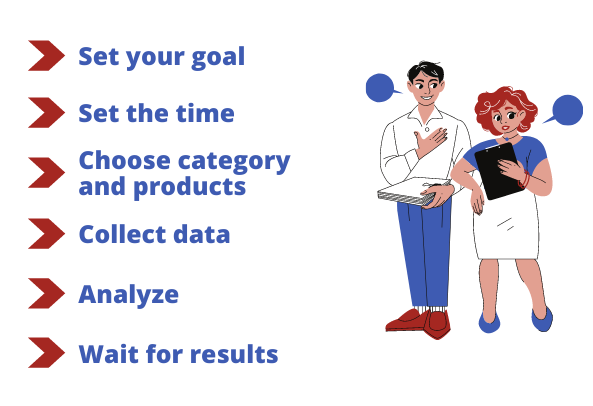
Price Testing Methods – The Complete Guide
It is never easy to set the right price and in a price-sensitive society like ours, if you don’t do it right, your business will be in some trouble. This is the key reason why you need to always carry out price testing, before jumping to any conclusions. We understand that this is not a simple task, so we prepared a guide containing the most common price testing methods as well as some deeper insights and explanations of price testing, to prepare you comprehensively for this important step.

As we said, price testing is very important for numerous reasons.
- Measure the elasticity of demand – to put it simply this is the percentage that shows you how the demand changes when you change the price.
- Creating a good pricing strategy – there is no way of creating a good pricing strategy without the right information, and price testing is one of the vital sources of that kind of information.
- Pricing new products – while it is not that hard to set the price for a product you’ve been selling for a long time, by simply looking at the data you already have, when it comes to pricing a brand new product, it can be more demanding. You will not have any historical data to look at, so you will have to rely on the data you gather by price testing.
- Pricing multiple tiers – price testing is the best way to decide how to set prices if you have a few different variations of your product – basic, regular, and premium for example.
Before You Start Price Testing
The question we are all here for is “How do you do price testing?” but there is no unique answer to it. First of all, we will propose some factors and steps you need to consider before even starting the price test – a sort of testing framework. When we cover that part, we will get to answering what are the methods of determining the price, by giving you an analysis of the most commonly used price testing methods.
Price Testing Framework

- Set your goal – you need to know what you want to achieve with the price test and the price change that will follow. Is it the revenue growth or the profit growth?
- Set the right time – timing is everything. You need to decide for how long you are going to run your test, and when is the best time to start with it.
- Choose category and products – this should be a category where you are selling a good volume of products.
- Collect data – conduct the test using the preferred price testing method and gather the important information.
- Analyze the results and put them into action – use the information you’ve collected to make data-driven pricing decisions.
- Wait for results – after a decent period from making your pricing decisions, you should check the results those decisions are bringing.
Price Testing Methods
In order to make it easier to understand, we separated all the price testing methods into two bigger categories – experiments and surveys.
- Under experiments, we consider all the methods that include price changes of products in your real offers.
- Surveys are testing methods where you ask for opinions about prices for particular products, instead of making changes directly in your store.
Experiments
A/B Testing
AB Testing is one of the most well-known price testing methods. As the name suggests, you should set two different prices for the same product and see which of the prices performs better for your product. Although this price testing method has its place, it shouldn’t be your primary way of testing prices.
For example, A/B testing can be used to test landing pages to see how small changes affect the conversion rate, but you shouldn’t use it to test different price points. There are more reasons for this:
- Can’t achieve the statistical significance – for the A/B test, you need a statistically significant amount of test subjects for valid results (so, you will need a lot of customers willing to buy your product).
- Other statistical factors – numbers are not the only problem. Willingness to purchase a product can change in a matter of days (let’s take the start of the COVID-19 Pandemic as an example) and the price is not the only factor affecting the decision – for example, if you change some details on your pricing page comparing the page you used for the test, you will need to do the whole testing again.
- You can upset your customers – despite the fact that most of the customers are aware of the dynamic pricing, there is more than one way of upsetting them by A/B testing. For example, you can disappoint your customers by offering them one price and when they decide to purchase a few days later, another one. Also, it is a bit questionable to offer different prices for the same product to different customers, and in the era of social media, it can really be backlash.
- The results are relative – you will only know how one price point is performing compared to another, not if this price is actually the best one for that product.
Other types of experiments
A/B testing is not the only price testing method that includes experimenting with the price. You can overcome some of its downsides by taking a different approach to the experiment. For example, you can offer a special discount instead of simply putting two different prices on the same product. However, while this will overcome some of the downsides, the others will remain. So, a better alternative for price testing might actually be the surveys.

Surveys
Compared to the experiments, surveys are better because you are just asking questions instead of offering the option to purchase, so, you are not promising anything, and therefore, the chances of making your customers angry are much smaller. Furthermore, when conducting a survey, you can carefully plan and choose the demographic and the test sample, which is not possible when doing the A/B test for example. So, if you do the preparation and set everything right, you can expect much more precise results compared to experimenting.
Monadic price test
This price testing method is appropriate for already developed products and when you already have an idea of what price range to market. In this method, multiple price points of the product are tested using a split cell test. You offer a product with its description and ask how likely is it for the customer to buy it for a certain price, giving the respondent options to choose from Extremely likely to Extremely unlikely on a scale of 1 to 7. After that, you repeat the question, just offering another price. You can repeat this process more than two times, to get more comprehensive results. The goal is to build the price sensitivity curve and gather purchase intent at different price points.
Price laddering
The price laddering (or the sequential monadic price test) has the same goal as the monadic price test. In this scenario, the respondents are shown a series of prices (usually from higher to lower) and asked to choose how likely are they to purchase for that price. If they don’t pick one of the top two options (most likely to purchase), they are shown the next, lower price, and the process repeats until they get to the price point they will likely purchase at. The main advantage is that this method requires a smaller sample size compared to the previous one.
However, this method also has its disadvantages – for example, asking the same question over different price points can tax the respondent, and previously shown prices can bias the response for the next shown price.
Conjoint analysis
In this price testing method, respondents are required to choose between a different set of product profiles. This means that you are offering different features for a certain price – so the respondents need to make tradeoffs between them. This is a great method to use if your product has not launched yet, and you don’t have a very clear image of the price range and the exact features you should offer. It is also good for products that can have more than one version, for example, a regular and a pro version of a smartphone.
NOTE – conducting surveys and gathering and analyzing data from them is very demanding. We always suggest consulting with experienced statisticians and data scientists in order to get the best results and avoid potential errors in your final results.
Monitor competitor prices
If you don’t sell a unique product, and other retailers are also offering the same product as you do, your price testing will be a bit easier, on the one hand, but more complicated on the other. This is because you can’t simply put some price on your product, you need to take into account the prices your competitors set for it. So, while you will have an idea of where to start, first you will need to gather this information. The best way to do this is by using a price monitoring tool. This way, you will avoid setting a price that is far from what your competitors are asking for a product. To put it simply, you will avoid creating your price strategy in the dark.
What to do next?
Free 14-day trial!
Start your Price2Spy trial now, and see how it can ease the process of implementing your pricing strategy.
Try for freeOnce you do the price testing and analyze your results, the job is not over. The most important part is yet to come. You need to make use of the conclusions you got from your research, by setting your pricing strategy. When you do this, the next step is to monitor how your prices are doing compared to your competitors’ prices. This way, you will be able to see if you did your price testing correctly.
Price2Spy is one of the best price monitoring software on the market. Furthermore, if you don’t have time to conduct the whole price testing process at the moment, Price2Spy offers a solution – the software will analyze your prices compared to your competitor’s prices and let you know if there is any room for improvement. You can also enable it to do the repricing automatically, according to your criteria.
Price testing is a demanding process that takes a lot of resources, including your time and money. You need to pay attention to a lot of different factors and choose the best price testing method that fits your needs.



